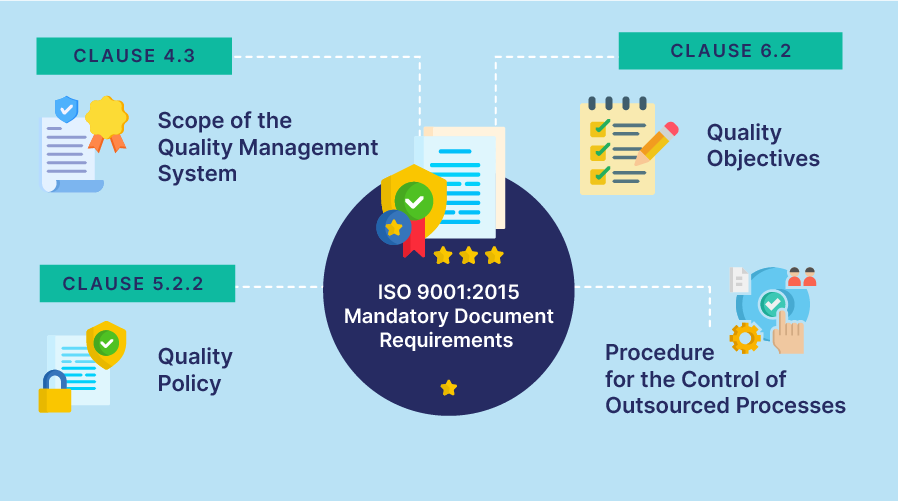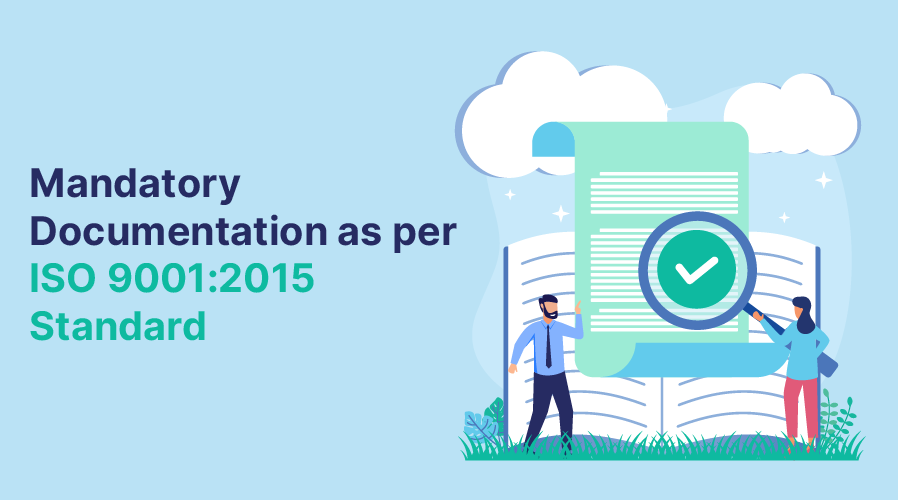ISO 9001:2015, the globally recognised standard for quality management systems, helps organisations demonstrate their commitment to quality, improve business performance, and ensure customer satisfaction. It is the only standard in the 9000 series that organisations can certify to. It was recently revised from 9001:2008 in 2015 to introduce improved leadership requirements and the need for risk-based analysis in QMS processes.
The standard focuses on organisational efficiency and continual improvement, as a part of which it requires organisations to fulfill certain documentation requirements. As opposed to the 2008 version, which listed mandatory 6 procedures, the 2015 version is much more flexible and lists 4 mandatory documents to ensure ISO 9001:2015 standard implementation and certification
This article will list the various mandatory documents and records as per the ISO 9001 standard.
ISO 9001:2015 Standard Mandatory Documentation
ISO 9001:2015 puts a strong emphasis on the documentation of processes, procedures, policies, and records to ensure effective QMS implementation and identify non-conformance. The information required by ISO 9001 standard can be divided into two types-
1. Documents: These are the key policies, processes, and objectives that support the organisation’s quality management system and can be revised later. These documents help you demonstrate the effectiveness of your QMS during an audit.
2. Records: Records are the proof of the results achieved under the QMS and cannot be revised as they are evidence.
Here are the 4 mandatory document requirements-

- Scope of the quality management system (clause 4.3)
- Quality Policy (clause 5.2.2)
- Quality Objectives (clause 6.2)
- Procedure for the control of outsourced processes
The list of mandatory documents for ISO 9001 certification include-
- Records of calibration and maintenance of monitoring and measuring equipment (Clause 7.1.5.1)
- Competence records (Clause 7.2)
- Products and services requirement review records (Clause 8.2.3.2)
- Design and development output review records (Clause 8.3.2)
- Design and development input records (Clause 8.3.3)
- Records of design and development controls (Clause 8.3.4)
- Records of design and development outputs (Clause 8.3.5)
- Records of design and development changes (Clause 8.3.6)
- Evidence of the conformity of products and services with acceptance criteria (Clause 8.6)
- Records of evaluation of external suppliers (Clause 8.4.1)
- Records of characteristics of products and services (Clause 8.5.1)
- Records of changes in products or services provided (Clause 8.5.6)
- Records of customer's property, including changes (Clause 8.5.3)
- Nonconformity records (Clause 8.7.2)
- Internal audit programs and results (Clause 9.2.2)
- Information on performance monitoring and measurement (Clause 9.1.1)
- Results of management reviews (Clause 9.3.3)
- Records of corrective action taken and opportunities for improvement (Clause 10.2.2)
In addition to the mandatory ISO documentation, there are various other non-mandatory documents required for certification. Some of the most commonly used non-mandatory documents include-
- Procedure for determining the context of the organisation and interested parties (Clauses 4.1 and 4.2)
- Procedure for identifying and addressing risks and opportunities (Clause 6.1)
- Procedure for competence, training, and awareness (Clauses 7.1.2, 7.2, 7.3)
- Procedure for the control of documents and records (Clause 7.5)
- Procedure for equipment maintenance and measuring equipment (Clause 7.1.5)
- Sales procedure (Clause 8.2)
- Design and development procedure (Clause 8.3)
- Production and service provisioning procedure (Clause 8.5)
- Warehousing procedure (Clause 8.5.4)
- Measuring customer satisfaction procedure (Clause 9.1.2)
- Internal audit procedure (Clause 9.2)
- Management review procedure (9.3)
- Nonconformity and corrective action procedure (Clauses 8.7 and 10.2)
Although ISO 9001:2015 does not require you to document the non-mandatory QMS procedures, many of these procedures are needed to create and manage the mandatory documentation. To determine whether to document a non-mandatory process, look at the probability of a process not happening as planned if it is left undocumented. If this probability is high, consider documenting the process to ensure effective QMS implementation and certification.
Document Control in ISO 9001
ISO 9001:2015 standard requires businesses to establish document control of the quality management system to ensure the integrity of data. This will also help bring transparency within the organisation and make sure that everyone has equal access to accurate information regarding quality management systems.
As a result, organisations must establish document control procedures to
- Set processes for document approval in terms of who will review it, how they will review it, and who has the right to approve it.
- Update the reviewed documents and ensure re-approval
- Identify changes to the document, manage document status, and establish an audit trail
- Make sure the documents are comprehensible and easily identifiable
- Make the documents available as and when needed
- Identify and control external documents
- Manage unauthorised use of obsolete documents
- Establish processes to identify and use obsolete documents if required again.
Manage ISO 9001:2015 Documentation with Effivity
Managing ISO 9001:2015 implementation and certification can be a lot more challenging if carried out manually. With various procedures to follow, processes to establish, and tons of documentation needs, manually implementing your QMS can often lead to inaccuracies, create delays, and make it difficult to track records.
Instead, when you use Effivity's ISO 9001:2015 Implementation and Certification Software, managing all the mandatory and non-mandatory ISO documentation becomes so much easier. The platform simplifies QMS and compliance by automating routine tasks, defining and updating compliance requirements, and digitising documents and records.
Moreover, in cases where there is no specific module for a clause, for instance, there is no separate module for the control of documents and records, this requirement will be met seamlessly in the background. Effivity is designed to take care of such requirements in all the documents and records that are generated by the system.
In fact, if you want to create and maintain records for non-mandatory procedures, Effivity lets you do that, too. Simply use the module to capture your company's details, and the required records will become available automatically.
Since ISO 9001:2015 documentation is a key aspect of ensuring compliance, it's important to have adequate processes and systems in place that make your job easy. Turn to Effivity - schedule a demo to learn more about the software today.






























